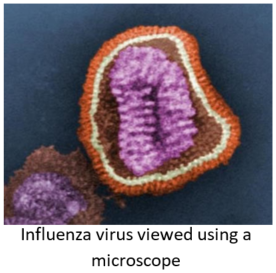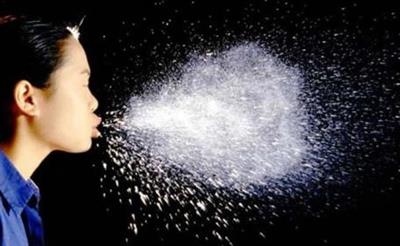 Indoor IPM Integrated Pest Management Newsletter – January 2018
Indoor IPM Integrated Pest Management Newsletter – January 2018
View this newsletter as a PDF.
Editor: Shujuan (Lucy) Li, lisj@cals.arizona.edu
Submitted by: Dawn H. Gouge (public health entomologist), Natalie Brassill (water quality assistant in
Extension, and Channah Rock (environmental microbiologist)
2017-2018 Flu Season is Particularly Bad.
 In many states the current flu season started earlier than usual, and the onset of flu season in November invariably led to increased transmission of infections during travel, and seasonal gatherings. Public health officials monitoring the number of flu related hospitalizations and outpatient visits have reported higher than normal case counts, and this could well indicate a severe flu season is in full swing. To date, widespread flu activity has been reported in 46 States according to the Centers for Disease Control and Prevention
In many states the current flu season started earlier than usual, and the onset of flu season in November invariably led to increased transmission of infections during travel, and seasonal gatherings. Public health officials monitoring the number of flu related hospitalizations and outpatient visits have reported higher than normal case counts, and this could well indicate a severe flu season is in full swing. To date, widespread flu activity has been reported in 46 States according to the Centers for Disease Control and Prevention
(CDC). In 26 states, flu activity has been classified as "high”
(see weekly CDC influenza maps https://www.cdc.gov/flu/weekly/usmap.htm).
Influenza is a highly contagious viral infection that causes the rapid onset of symptoms. The symptoms may start mildly, but often increase in severity rapidly, sometimes in a matter of hours. People who have the flu often feel some or all of these symptoms:
Any person experiencing chest pain or breathing complications should seek immediate medical assistance.
Pneumonia-like symptoms include serious congestion, chest pain, difficulty breathing, fever of 102oF or higher, and/or coughing that produces pus. Pneumonia in very young children or in adults older than 65 is cause for concern as the symptoms can become life-threatening, and may result in death if left untreated. Bronchitis, sinus and ear infections are other common complications resulting from the flu virus.
The flu can also exacerbate (make worse) chronic health problems like asthma and chronic obstructive pulmonary disease (COPD).
Most people recover completely within two weeks, but some develop complications, such as pneumonia. Influenza antiviral drugs may be prescribed to treat influenza infections. There are three different antiviral drugs that are recommended for use in the United States for the treatment of influenza: oseltamivir, peramivir and zanamivir.
Across North America there are a number of influenza virus (strains) causing illness, but the strain most commonly causing individuals to seek medical attention currently is influenza A H3N2. The H3N2 virus affects seniors and young children to a greater extent, and symptoms tend to be more severe compared to other influenza A or B strains.
In attempts to reduce the spread of the flu virus and other pathogens (microorganisms that cause disease) caregivers often reach for disinfectant wipes in homes, classrooms, and childcare centers, but may not realize that disinfectant wipes are registered pesticides as they are designed to kill, or inactivate microbes. Disinfectant products can be used in residential settings, schools, childcare facilities and medical centers safely and effectively, but there are a few things everyone should know:
It is inappropriate to ask children to clean desks and surfaces with disinfectant wipes.
Children are not legally allowed to handle disinfectant wipes and this is a Federal law and many
labels clearly state “KEEP OUT OF REACH OF CHILDREN”
 So how can caregivers and facility managers maintain a healthy indoor environments, and limit the spread of the flu virus? Flu viruses spread from person to person mainly by droplets made when people with flu cough, sneeze, or talk. Less often, a person might get the flu by touching a contaminated surface or object then touching their own mouth, eyes, or nose. Most healthy adults may be able to infect other people beginning 1 day before symptoms develop and up to 7 days after becoming sick. Children may pass the virus for longer than 7 days. Symptoms start 1 to 4 days after the flu virus enters the body.
So how can caregivers and facility managers maintain a healthy indoor environments, and limit the spread of the flu virus? Flu viruses spread from person to person mainly by droplets made when people with flu cough, sneeze, or talk. Less often, a person might get the flu by touching a contaminated surface or object then touching their own mouth, eyes, or nose. Most healthy adults may be able to infect other people beginning 1 day before symptoms develop and up to 7 days after becoming sick. Children may pass the virus for longer than 7 days. Symptoms start 1 to 4 days after the flu virus enters the body.
This means that you are able to pass on the flu to someone
else before you feel sick yourself
To minimize flu:


When addressing pathogens in the built environment, select the cleaning product based on the need. While soapy water is sufficient to clean up a drink spill, it is not the best option for all jobs, for example, a disinfectant is required to clean wrestling mats to prevent the spread of infectious skin diseases like ringworm (a fungal infection of the skin). Remember that disinfectants are registered pesticides and therefore the label must be followed in order to avoid health problems, such as eye injuries, chemical burns, and respiratory illness, as well as to achieve effective disinfection.
Citations
National Pesticide Information Center http://npic.orst.edu/health/readlabel.html Washington State University https://schoolipm.wsu.edu/microorganisms/